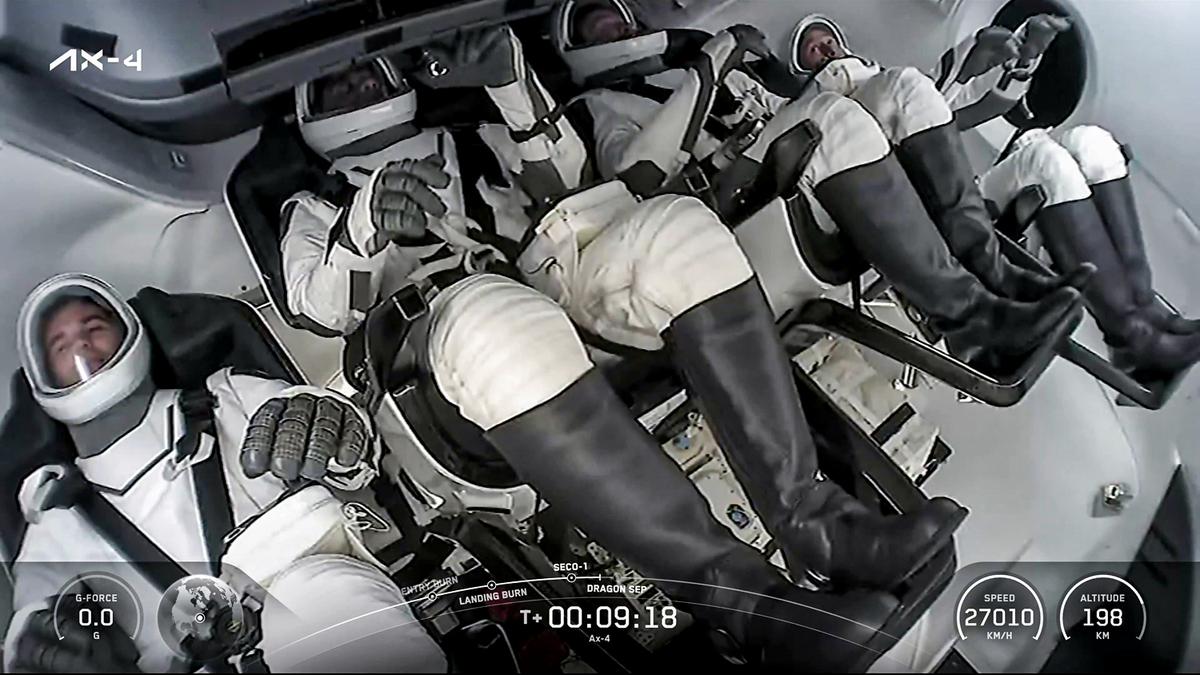At 12.01 pm IST on June 25, a crew capsule containing four astronauts, including India’s Group Capt. Shubhanshu Shukla on his first spaceflight, lifted off atop a Falcon 9 rocket from NASA’s spaceport in Florida.
The lift-off marked the start of the long-awaited Axiom-4 mission.
The launch was smooth. By the time the rocket’s two stages had completed their work, the crew capsule — called Dragon — was travelling at several thousand kilometres per hour.
The capsule’s destination was the International Space Station (ISS), which is orbiting the earth at roughly 400 km above sea level. At the time of lift-off, Axiom Space, the company orchestrating this mission, said Dragon would dock with the ISS in 28 hours.
Why does a spacecraft travelling so fast need 28 hours to reach a place that’s little more than the distance between Chennai and Bengaluru away?
It helps to picture the capsule and the ISS as two race-cars on separate lanes of the same track rather than as a car trying to drive straight up to a spot 400 km ahead.
Everything happens sideways around the earth, and the choreography is dictated by orbital mechanics and strict safety rules.
To share the ISS’s lane, the capsule needs to match both its altitude and its velocity vector. This is achieved using raw speed as well as timing.
Rather than impart energy to the crew capsule in a radially outward direction, it’s mostly sideways. Going straight up 400 km would leave Dragon with virtually zero sideways speed, causing it to fall back almost immediately — like a ball that has been thrown up.
The Falcon 9 rocket will have vaulted Dragon into a low, slightly elliptical parking orbit about 200 km high. Its speed there is around 27,000 km/hr, which the capsule maintains just to avoid spiralling back down towards the ground.
The ISS is also higher than this parking orbit, at around 400 km, and therefore circles the earth a little more slowly to avoid spiralling down. While the ISS takes around 92 minutes to go around the earth once, Dragon starts by taking around 88 minutes. Thus, by being lower than the ISS, Dragon slowly falls behind in its orbit until it has caught up with the ISS.
After its system check-outs, the Dragon capsule will perform a series of small thruster burns, a.k.a. phasing burns, to first raise its apogee (the point in its elliptical orbit where Dragon is farthest from the earth) and then its whole orbit.
Each of these burns is timed such that after completing several orbits, Dragon ends up being exactly where the ISS will be. This is somewhat like merging into a highway at the right exit rather than steering straight towards another car.
For the Axiom-4 mission, the mission planners designed a pre-docking profile that lasted about 28 hours, or about 18 orbits. At the end of this profile, the Dragon crew capsule would be on the correct side of the ISS, where a free docking port is located, and at a time when the ISS crew is awake.
Once Dragon comes within 30 km or so of the ISS, it will move itself to a ‘corridor’ aligned with the ISS. From here, the rules require the capsule to move at no more than a few metres per second. Once it’s within 20 m of the ISS, Dragon will have to slow to a few centimetres per second.
There are holding points at 400 m, 220 m, 20 m, and 1 m from the ISS, where the Dragon crew, including Group Capt. Shukla — who is the designated mission pilot — will have to perform GO/NO-GO polls and LIDAR checks. Even if there is one wrong sensor reading in this process, Dragon will be required to retreat from the ISS along a pre-programmed path.
This deliberate pacing alone adds several hours to the crew capsule’s approach towards the ISS.
The fact that Axiom Space and NASA used SpaceX’s Dragon crew capsule for this mission is important. It allowed the mission operators to opt for a more conservative, fuel-rich profile that also allows the crew to finish check-outs, eat, and sleep before the intense docking exercise.
Published – June 26, 2025 03:30 pm IST
